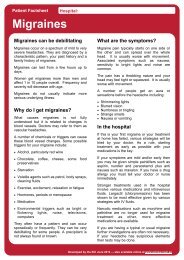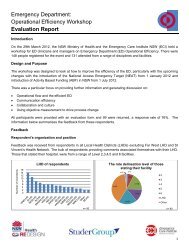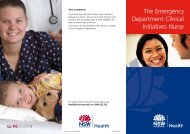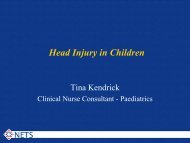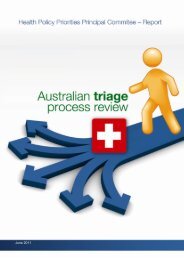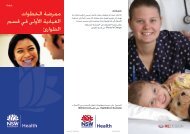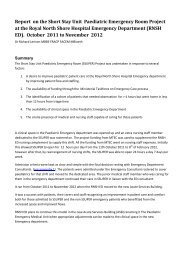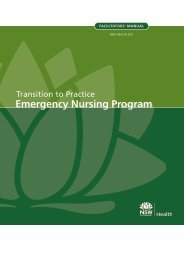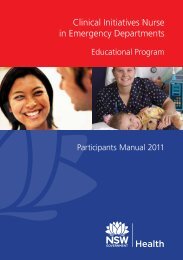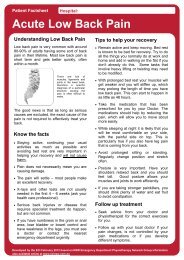Emergency Department Models of Care 2012 - NSW Health
Emergency Department Models of Care 2012 - NSW Health
Emergency Department Models of Care 2012 - NSW Health
- No tags were found...
You also want an ePaper? Increase the reach of your titles
YUMPU automatically turns print PDFs into web optimized ePapers that Google loves.
Challenges ■ Identification <strong>of</strong> ‘MAU-appropriate patients’ prior to or at entry into the hospital■■■■Community and ED staff education about patient suitability for the MAUED MAUs are used as an overflow unit when the ED is busyMAU used as a holding bay until ward beds become availableMAU used for acute inpatient admissions when inpatient beds are not available.Case for implementationWhat you need to runthe modelTo assess the need to implement this model to support your ED and hospital, consider thefollowing:■■■■■■Does your ED experience inefficient patient flow?Are medical patients managed for extended periods in the ED?Is there good coordination <strong>of</strong> care for medical patients with the community?Is your hospital meeting the 4-hour National <strong>Emergency</strong> Access Target?What proportion <strong>of</strong> ED presentations are undifferentiated, complex, chronic, non-criticalmedical patients?What is the readmission rate for the complex medical patients in your hospital?Governance■■Executive sponsor (i.e. General Manager) who states, models and reinforces that theMAU model <strong>of</strong> care is critical to the success <strong>of</strong> the whole hospitalMAU Executive Management Committee that meets regularly and is able to action issuesimmediately. This Committee will include representatives from the hospital Executive,Patient Flow, ED-medical and nursing, MAU medical, nursing and allied health.Medical staff:■■■Medical Director specifically dedicated to the MAU to provide clinical leadership,governance and medical services for patients in the MAU. The provision <strong>of</strong> seniorphysician cover and presence in the MAU is vital for its success.Admitting medical <strong>of</strong>ficer (AMO) dedicated/on-take/rotating to accept patients rapidlyinto the MAU either from the community, at ED Triage or from within the ED.Dedicated medical staffing (CMO, Registrar level) for the MAU to provide immediateaccess to medical assessment and to accept patients directly into the MAU, or enabletransfer from ED within a short period <strong>of</strong> time.Nursing staff:■■■Nursing Unit Manager (NUM) to lead the MAU team. The size <strong>of</strong> the bed-base orco-location to another ward will determine if the NUM is dedicated to the MAU only orhas another unit/ward responsibilities<strong>Care</strong> Coordinator position. Ideally a Nurse Practitioner (NP) or Clinical Nurse Consultant(CNC) who is responsible for coordinating care across the patients’ journey (inclusive <strong>of</strong>pre- and post-MAU) in collaboration with the multidisciplinary team.The current 1:4 nurse patient ratio is recommended for the MAU due to the patientcohort (undifferentiated, complex, chronic, non-critical medical patients) and high patientturnover (48-hour length <strong>of</strong> stay).Allied <strong>Health</strong> staff:■■Allied <strong>Health</strong> staff are critical to the functioning <strong>of</strong> the MAU and in providingcoordinated care at the point <strong>of</strong> entry into the hospital to promote patient function andto expedite patient assessment, treatment, referral and discharge.Allied <strong>Health</strong> staff should be dedicated to the MAU and not allocated on a rotationalbasis or daily/weekly/monthly batching from the Allied <strong>Health</strong> department.<strong>Models</strong> <strong>of</strong> <strong>Emergency</strong> <strong>Care</strong> <strong>NSW</strong> HEALTH PAGE 47




